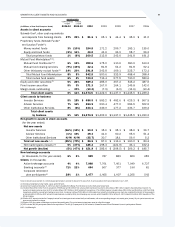Charles Schwab 2010 Annual Report Download - page 21
Download and view the complete annual report
Please find page 21 of the 2010 Charles Schwab annual report below. You can navigate through the pages in the report by either clicking on the pages listed below, or by using the keyword search tool below to find specific information within the annual report.
THE CHARLES SCHWAB CORPORATION
As a registered broker-dealer, Schwab is subject to Rule 15c3-1 under the Securities Exchange Act of 1934 (the Uniform Net Capital
Rule) and related SRO requirements. The CFTC and NFA also impose net capital requirements. The Uniform Net Capital Rule
specifies minimum capital requirements that are intended to ensure the general financial soundness and liquidity of broker-dealers.
Because CSC itself is not a registered broker-dealer, it is not subject to the Uniform Net Capital Rule. However, if Schwab failed to
maintain specified levels of net capital, such failure would constitute a default by CSC under certain debt covenants.
The Uniform Net Capital Rule limits broker-dealers’ ability to transfer capital to parent companies and other affiliates. Compliance
with the Uniform Net Capital Rule could limit Schwab’s operations and its ability to repay subordinated debt to CSC, which in turn
could limit CSC’s ability to repay debt, pay cash dividends, and purchase shares of its outstanding stock.
Sources of Net Revenues
The Company’s major sources of net revenues are asset management and administration fees, net interest revenue, and trading
revenue. The Company generates asset management and administration fees through its proprietary and third-party mutual fund
offerings, as well as fee-based investment management and advisory services. Net interest revenue is the difference between interest
earned on interest-earning assets (such as cash, short- and long-term investments, and mortgage and margin loans) and interest paid
on funding sources (including banking deposits and client cash in brokerage accounts, short-term borrowings, and long-term debt).
The Company generates trading revenue through commissions earned for executing trades for clients and principal transaction
revenue from trading activity in fixed income securities.
For revenue information by source for the three years ended December 31, 2010, see “Item 7 – Management’s Discussion and
Analysis of Financial Condition and Results of Operations – Results of Operations – Net Revenues.”
Available Information
The Company files annual, quarterly, and current reports, proxy statements, and other information with the SEC. The Company’s
SEC filings are available to the public over the Internet on the SEC’s website at http://www.sec.gov. You may read and copy any
document that the Company files with the SEC at the SEC’s Public Reference Room at 100 F Street, NE, Washington, DC 20549.
You may obtain information on the operation of the Public Reference Room by calling the SEC at 1-800-SEC-0330.
On the Company’s Internet website, http://www.aboutschwab.com, the Company posts the following recent filings as soon as
reasonably practicable after they are electronically filed with or furnished to the SEC: the Company’s annual reports on Form 10-K,
the Company’s quarterly reports on Form 10-Q, the Company’s current reports on Form 8-K, and any amendments to those reports
filed or furnished pursuant to Section 13(a) or 15(d) of the Securities Exchange Act of 1934. All such filings are available free of
charge either on the Company’s website or by request via email (investor.relations@schwab.com), telephone (415-667-1959), or mail
(Charles Schwab Investor Relations at 211 Main Street, San Francisco, CA 94105).
Item 1A. Risk Factors
The Company faces a variety of risks that may affect its operations or financial results, and many of those risks are driven by factors
that the Company cannot control or predict. The following discussion addresses those risks that management believes are the most
significant, although there may be other risks that could arise, or may prove to be more significant than expected, that may affect the
Company’s operations or financial results.
For a discussion of the Company’s risk management, including technology and operating risk, credit risk, concentration risk, market
risk, fiduciary risk, and legal and regulatory risk, see “Item 7 – Management’s Discussion and Analysis of Financial Condition and
Results of Operations – Risk Management.”
-6 -
























